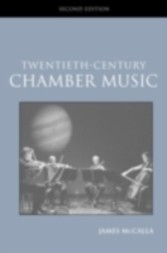
20th Century Chamber Music, 2nd Ed

von: James McDalla
Routledge, 2003
ISBN: 9780203493076
Sprache: Englisch
289 Seiten, Download: 4341 KB
Format: PDF, auch als Online-Lesen
CHAPTER TWO Music and Literature I: Program Music (p. 32-33)
The years from 1899, the year of Verklärte Nacht, through the First World War saw an enormous output of programmatic chamber music. This activity largely disappears in the years between the World Wars, the years of so-called neoclassicism,1 and reappears after 1945. But, as we shall see, there is a fundamental difference between programmatic chamber music composed before World War I and after World War II. The earlier music tells a story or depicts a scene, as we saw in Schoenberg’s Verklärte Nacht and the two Ives sonatas for violin and piano. The later music, like the earlier, often uses titles, but now those titles more often describe the work itself rather than anything extramusical, or are so general that one cannot find in them a program for the music.2 In the music of the post-World War II era, though, we will find a concern with contemporary literature, especially with literary techniques, as for example in the conception of a poem as a ""scaffolding"" (the term is Boulez’s) on which the composer may construct his or her music. We also find in these years a widespread interest of various composers in early twentieth-century literature, especially in Joyce. The focus of this chapter is on how the music discussed here is more or less specifically programmatic. We are interested here, for example, in who is telling a story and in how that narrator is doing so. We are also interested in matters of time, which will prove to be of some importance for nonprogrammatic music as well.
Narrative and Temporal Programs: Berg and Carter
Some narrative music conveys a story that cannot be told in verbal terms, at least in verbal terms analogous to the musical-poetic narrative in Schoenberg’s Verklärte Nacht. One example is Alban Berg’s Lyric Suite (1926). In this string quartet, the tempi of the movements move outward like a wedge from the initial moderato, the odd-numbered movements becoming progressively faster and the even-numbered progressively slower.
An element of Berg’s genius was his ability to make seemingly static formal designs dramatic, to use them for movement, tension and release, and immediate and lasting emotional impact, this ability is evident not only in his operas, Lulu and Wozzeck, but in his instrumental ""absolute"" works as well. The Lyric Suite’s bifurcation of tempo leaves one with the mental image, when the piece is over, of an unbridgeable chasm. Furthermore, at the end of the last movement is a quotation from Tristan und Isolde—its most famous motive, the beginning of the prelude. Berg’s listener will not simply register this as an homage to Wagner but will hear, through the quotation, an expression of infinite longing. The listener will also realize that the quotation is not fulfilled or resolved, for example with a following quotation from the Liebestod. An unbridgeable chasm and unresolved longing: perhaps this is what the Lyric Suite is ""about""?
For years there were discussions of a possible secret program for the Lyric Suite. In the early 1980s the composer George Perle published the results of his extensive research and demonstrated the string quartet’s hidden program. In fact, the last movement, largo desolato, is a ""setting"" of Baudelaire’s poem ""De profundis clamavi"" (""From the depths have I cried to you"") from Les fleurs du mal, with the ""vocal"" lines—that is, the melodic lines to which Berg subscribed the words of the poem—divided variously among the four instruments. In its private program, which the composer never intended to be made generally known, the Lyric Suite is addressed to a woman—not his wife—with whom Berg was in love. Thus the purely musical sense of an unbridgeable chasm and of the unfulfilled longing of the first act of Tristan und Isolde are fixed in a specific biographical situation.
In a way, this overlapping of private and public programs parallels Berg’s use of conventional musical forms for seemingly unrelated dramatic impact. In such cases, the performers may be aware of the musical structures, but it is not essential that an audience be attentive to them. In the case of the private program of the Lyric Suite, it is no doubt helpful for the performers to know the program, the Baudelaire sonnet, and even the instrumental lines underlain with the sonnet text, but the work is not to be performed as a poetic setting, for voice and string quartet accompaniment. Such a performance distorts the quartet textures, obscuring the interplay of the instruments and emphasizing the ""sung"" lines at the expense of the rest of the music. At most, the Baudelaire might be printed in the program, but even this may be too much, perhaps emphasizing the anecdotal over the work itself."







